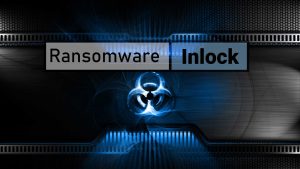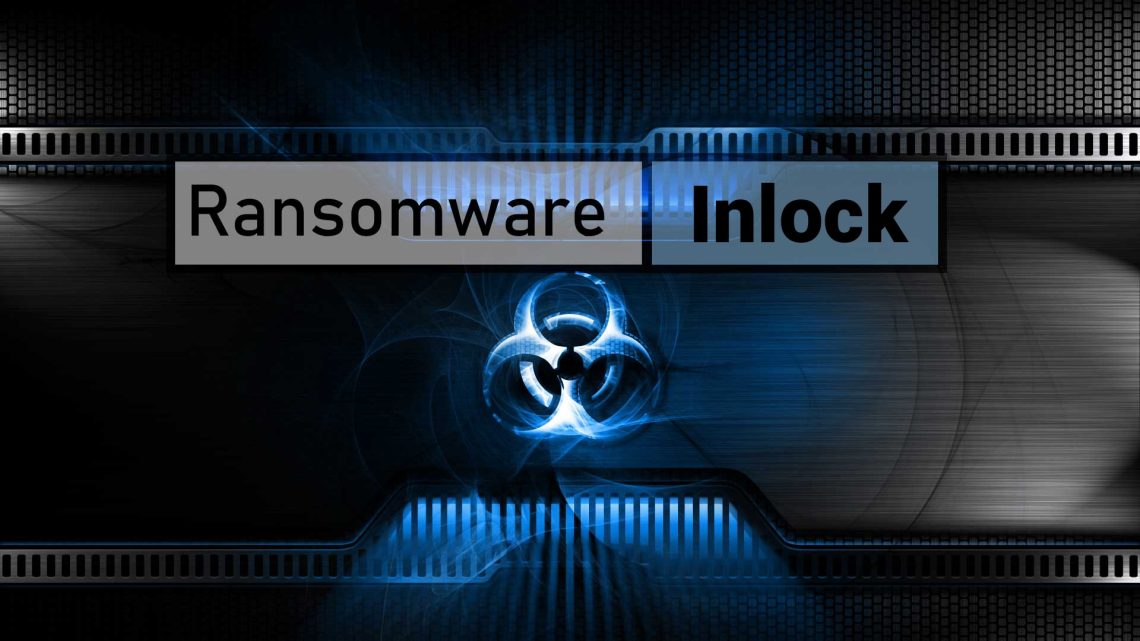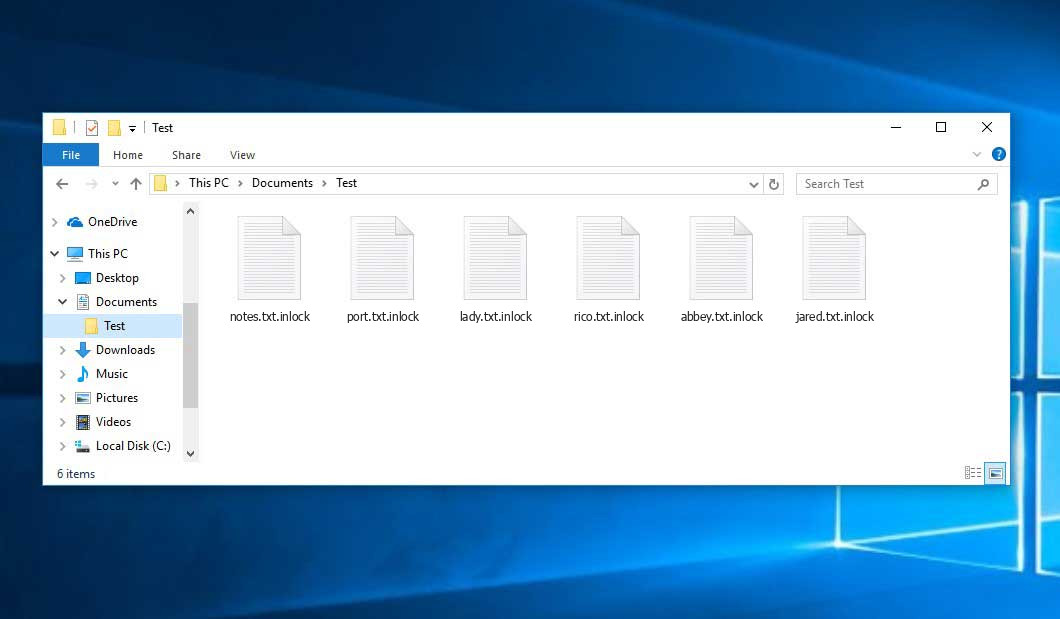The Inlock virus falls within the ransomware type of infection. A harmful program of such sort encrypts all user’s data on the PC (images, text files, excel sheets, audio files, videos, etc) and adds its own extension to every file, leaving the READ_IT.txt text files in every directory which contains the encrypted files.
What is known about the Inlockvirus?
☝️ A scientifically accurate denomination for the Inlock is “a ransomware malicious agent”.
Inlock appends its specific .inlock extension to the title of every encoded file. For example, an image entitled “photo.jpg” will be altered to “photo.jpg.inlock”. Just like the Excel table named “table.xlsx” will become “table.xlsx.inlock”, and so on.
In every directory with the encoded files, a READ_IT.txt file will appear. It is a ransom money note. Therein you can find information about the ways of paying the ransom and some other information. The ransom note usually contains a description of how to purchase the decryption tool from the ransomware developers. That is basically the scheme of the felony.
Inlock overview:
| Name | Inlock Virus |
| Extension | .inlock |
| Ransomware note | READ_IT.txt |
| Detection | UDS:Trojan-Ransom.Win32.GenericML.xnet, Ransom:Win32/StopCrypt.SU!MTB, Trojan:Win32/Redline.WON!MTB |
| Symptoms | Your files (photos, videos, documents) get a .inlock extension and you can’t open them. |
| Fix Tool | See If Your System Has Been Affected by Inlock virus |
The READ_IT.txt document coming in package with the Inlock ransomware provides the following frustrating information:
¡¡¡TU EQUIPO HA SIDO CIFRADO!!! Lo sentimos mucho, pero has sido objectivo de un ciberataque. Todos tus datos personales han sido cifrados. Ponte encontacto conmigo para negociar el rescate. Una vez me llegue el pago, te haré llegar la herramienta encargada de descifrar todos los ficheros. Espero que no tengas nada de gran valor ;) El siguiente código no lo pierdas o no podrás recuperar nunca más tus datos:
In the picture below, you can see what a directory with files encrypted by the Inlock looks like. Each filename has the “.inlock” extension added to it.
How did my computer get infected with Inlock ransomware?
There are plenty of possible ways of ransomware injection.
There are currently three most popular ways for hackers to have the Inlock virus acting in your system. These are email spam, Trojan infiltration and peer-to-peer file transfer.
If you access your inbox and see emails that look just like notifications from utility services providers, delivery agencies like FedEx, web-access providers, and whatnot, but whose “from” field is unknown to you, beware of opening those letters. They are very likely to have a harmful item enclosed in them. So it is even riskier to open any attachments that come with letters like these.
Another option for ransom hunters is a Trojan horse scheme1. A Trojan is an object that infiltrates into your PC pretending to be something different. For instance, you download an installer for some program you need or an update for some program. But what is unboxed turns out to be a harmful program that encrypts your data. As the installation package can have any name and any icon, you have to make sure that you can trust the source of the things you’re downloading. The best thing is to use the software developers’ official websites.
As for the peer file transfer protocols like BitTorrent or eMule, the danger is that they are even more trust-based than the rest of the Web. You can never guess what you download until you get it. Our suggestion is that you use trustworthy resources. Also, it is reasonable to scan the directory containing the downloaded objects with the anti-malware utility as soon as the downloading is finished.
How to remove the Inlock virus?
It is crucial to inform you that besides encrypting your files, the Inlock virus will most likely deploy the Azorult Spyware on your machine to seize your credentials to different accounts (including cryptocurrency wallets). That spyware2 can derive your logins and passwords from your browser’s auto-filling data.
Sometimes criminals would decrypt some of your files so you know that they really have the decryption tool. Since Inlock virus is a relatively new ransomware, anti-malware designers have not yet found a method to undo its work. Nevertheless, the decryption tools are constantly upgraded, so the solution may soon be available.
Understandably, if the criminals succeed in encoding victim’s critical data, the desperate person will probably comply with their demands. However, paying to criminals does not necessarily mean that you’re getting your data back. It is still risky. After receiving the ransom, the racketeers may deliver a wrong decryption code to the victim. There were reports about criminals simply disappearing after getting the money without even bothering to reply.
The best safety measure against ransomware is to have aan OS restore point or the copies of your critical files in the cloud drive or at least on an external storage. Obviously, that might be insufficient. The most important thing could be that one you were working upon when it all went down. But at least it is something. It is also advisable to scan your drives with the anti-malware utility after the system restoration.
There are other ransomware products, besides Inlock, that work similarly. Examples of those are Towz, Powd, Tuow, and some others. The two basic differences between them and the Inlock are the ransom amount and the encoding method. The rest is the same: documents become encrypted, their extensions altered, ransom notes appear in each folder containing encoded files.
Some lucky people were able to decode the blocked files with the aid of the free tools provided by anti-ransomware experts. Sometimes the criminals mistakenly send the decryption key to the wronged in the ransom note. Such an extraordinary fail allows the user to restore the files. But obviously, one should never rely on such a chance. Remember, ransomware is a bandits’ instrument to pull the money out of their victims.
How сan I avoid ransomware injection?
Inlock ransomware has no endless power, so as any similar malware.
You can protect your PC from ransomware attack within several easy steps:
- Ignore any emails from unknown mailers with strange addresses, or with content that has likely no connection to something you are expecting (can you win in a lottery without participating in it?). If the email subject is more or less something you are expecting, scrutinize all elements of the suspicious email carefully. A fake letter will always have mistakes.
- Do not use cracked or untrusted software. Trojan viruses are often spreaded as an element of cracked software, possibly as a “patch” which prevents the license check. Understandably, potentially dangerous programs are very hard to distinguish from trustworthy ones, as trojans may also have the functionality you seek. You can try searching for information about this program on the anti-malware message boards, but the best solution is not to use such software.
- And to be sure about the safety of the files you downloaded, use GridinSoft Anti-Malware. This software will be a powerful armor for your PC.
Reasons why I would recommend GridinSoft3
There is no better way to recognize, remove and prevent ransomware than to use an anti-malware software from GridinSoft4.
Download Removal Tool.
You can download GridinSoft Anti-Malware by clicking the button below:
Run the setup file.
When setup file has finished downloading, double-click on the setup-antimalware-fix.exe file to install GridinSoft Anti-Malware on your system.

An User Account Control asking you about to allow GridinSoft Anti-Malware to make changes to your device. So, you should click “Yes” to continue with the installation.

Press “Install” button.

Once installed, Anti-Malware will automatically run.

Wait for the Anti-Malware scan to complete.
GridinSoft Anti-Malware will automatically start scanning your computer for Inlock infections and other malicious programs. This process can take a 20-30 minutes, so I suggest you periodically check on the status of the scan process.

Click on “Clean Now”.
When the scan has finished, you will see the list of infections that GridinSoft Anti-Malware has detected. To remove them click on the “Clean Now” button in right corner.

Frequently Asked Questions
🤔 How can I open “.inlock” files?Are the “.inlock” files accessible?
There’s no way to do it, unless the files “.inlock” files are decrypted.
🤔 I really need to decrypt those “.inlock” files ASAP. How can I do that?
Hopefully, you have made a copy of those important files. In case you haven’t, there is still a chance that you do have a Restore Point from some time ago to roll back the whole system to the moment when it had no virus yet, but already had your files. The rest of the methods require patience.
🤔 If GridinSoft deletes the Inlock malware, will it also delete my files that were encrypted?
Of course not. The encrypted files are not harmful, so they won’t be deleted.
GridinSoft Anti-Malware will remove the malware from your computer. The virus that has infected your PC is most likely still functional and it scans your system from time to time to encode any new files you might create on your PC after the initial attack. As it has already been said, the Inlock virus does not come alone. It installs backdoors and keyloggers that can steal your account credentials and provide malefactors with easy access to your computer after some time.
🤔 What should I do if the Inlock ransomware has blocked my PC and I can’t get the activation code.
In such a case, you need to have a flash memory card with a pre-installed Trojan Killer. Use Safe Mode to execute the procedure. The point is that the ransomware starts automatically as the system launches and encodes any new files created or imported into your system. To suppress this function – use Safe Mode, which allows only the essential programs to run automatically. Consider reading our manual on booting Windows in Safe Mode.
🤔 What can I do right now?
Some of the encrypted data can be located elsewhere.
- If you exchanged your critical files via email, you could still download them from your online mail server.
- You might have shared photographs or videos with your friends or relatives. Simply ask them to send those pictures back to you.
- If you have initially downloaded any of your files from the Internet, you can try downloading them again.
- Your messengers, social media pages, and cloud storage might have all those files as well.
- Maybe you still have the needed files on your old PC, a laptop, cellphone, memory stick, etc.
USEFUL TIP: You can use data recovery programs5 to get your lost data back since ransomware blocks the copies of your files, deleting the original ones. In the tutorial below, you can see how to recover your files with PhotoRec, but remember: you won’t be able to do it before you eradicate the virus with an antivirus program.
Also, you can contact the following governmental fraud and scam sites to report this attack:
- In the United States: On Guard Online;
- In Canada: Canadian Anti-Fraud Centre;
- In the United Kingdom: Action Fraud;
- In Australia: SCAMwatch;
- In New Zealand: Consumer Affairs Scams;
- In France: Agence nationale de la sécurité des systèmes d’information;
- In Germany: Bundesamt für Sicherheit in der Informationstechnik;
- In Ireland: An Garda Síochána;
To report the attack, you can contact local executive boards. For instance, if you live in USA, you can have a talk with FBI Local field office, IC3 or Secret Service.
I need your help to share this article.
It is your turn to help other people. I have written this guide to help people like you. You can use the buttons below to share this on your favorite social media Facebook, Twitter, or Reddit.
Brendan SmithHow to Remove INLOCK Ransomware & Recover PC

Name: INLOCK Virus
Description: INLOCK Virus is a ransomware-type infections. This virus encrypts important personal files (video, photos, documents). The encrypted files can be tracked by a specific .inlock extension. So, you can't use them at all.
Operating System: Windows
Application Category: Virus
User Review
( votes)References
- You can read more on Trojans, their use and types in the Trojan-dedicated section of GridinSoft official website.
- You can read more on spyware variants and nature in the respective section of GridinSoft official website.
- GridinSoft Anti-Malware Review from HowToFix site: https://howtofix.guide/gridinsoft-anti-malware/
- More information about GridinSoft products: https://gridinsoft.com/comparison
- Here’s the list of Best Data Recovery Software Of 2023.



